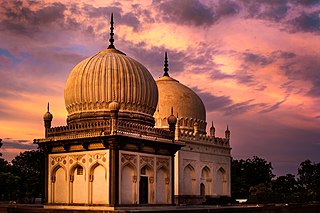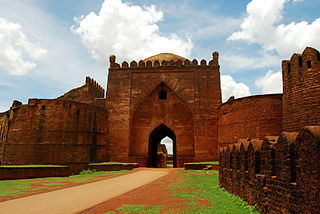
The Deccan sultanates were five late-medieval Indian kingdoms—on the Deccan Plateau between the Krishna River and the Vindhya Range—that were ruled by Muslim dynasties: namely Ahmadnagar, Berar, Bidar, Bijapur, and Golconda. The sultanates had become independent during the break-up of the Bahmani Sultanate. The five sultanates owed their existence to the declaration of independence of Ahmadnagar in 1490, followed by Bijapur and Berar in the same year. Golconda became independent in 1518, and Bidar in 1528.

The Charminar is a monument located in Hyderabad, Telangana, India. Constructed in 1591, the landmark is a symbol of Hyderabad and officially incorporated in the emblem of Telangana. The Charminar's long history includes the existence of a mosque on its top floor for more than 425 years. While both historically and religiously significant, it is also known for its popular and busy local markets surrounding the structure, and has become one of the most frequented tourist attractions in Hyderabad. Charminar is also a site of numerous festival celebrations, such as Eid-ul-adha and Eid al-Fitr, as it is adjacent to the city's main mosque, the Makkah Masjid.

The Qutb Shahi dynasty was a Persianate Shia Islamic dynasty of Turkoman origin that ruled the Sultanate of Golkonda in southern India. After the collapse of Bahmani Sultanate, the Qutb Shahi dynasty was established in 1512 AD by Sultan-Quli Qutb-ul-Mulk, better known though less correctly referred to in English as "Quli Qutb Shah".

Ibrahim Qutb Shah Wali, also known by his Telugu names Malki BhaRama and Ibharama Cakravarti, was the fourth monarch of the kingdom of Golconda in southern India. He was the first of the Qutb Shahi dynasty to use the title "Sultan". He ruled from 1550 to 1580. He lived for seven years in exile at the court of Vijayanagara as an honoured guest of Rama Raya. Ibrahim is known for patronizing Telugu extensively because he was moved by a genuine love for the language.
Sultan Quli Qutb-ul-Mulk, more often though less correctly referred to in English as Quli Qutb Shah (1485–1543), was the founder of the Qutb Shahi dynasty, which ruled the Sultanate of Golconda in southern India from 1518 to 1687. Of Turkmen origin and born in Persia, he originally served the Bahmani sultan, and was awarded the title Qutb-ul-Mulk as military chief; he eventually took control of Golconda.

Sultan Muhammad Qutb Shah was the sixth ruler of the kingdom of Golconda in southern India under the Qutb Shahi dynasty.

Golconda is a fortified citadel and ruined city located in the western outskirts of Hyderabad, Telangana, India. The fort was originally built by Kakatiya ruler Pratāparudra in the 11th century out of mud walls. It was ceded to the Bahmani Kings by Deo Rai, Rajah of Warangal during the reign of Sultan Muhammad Shah of the Bahmani Sultanate. Following the death of Sultan Mahmood Shah, the Sultanate disintegrated and Sultan Quli, who had been appointed as the Governor of Hyderabad by the Bahmani Kings, fortified city and made it the capital of the Golconda Sultanate. Because of the vicinity of diamond mines, especially Kollur Mine, Golconda flourished as a trade centre of large diamonds known as Golconda Diamonds. Golconda fort is currently abandoned and in ruins. The complex was put by UNESCO on its "tentative list" to become a World Heritage Site in 2014, with others in the region, under the name Monuments and Forts of the Deccan Sultanate.
The Aga Khan Trust for Culture (AKTC) is an agency of the Aga Khan Development Network (AKDN), a family of institutions created by Aga Khan IV with distinct but complementary mandates to improve the welfare and prospects of people in the developing world, particularly in Asia and Africa. It focuses on the revitalization of communities in the Muslim world—physical, social, cultural, and economic. The AKTC was founded in 1988 and is registered in Geneva, Switzerland, as a private non-denominational philanthropic foundation.

The Qutub Shahi Tombs are located in the Ibrahim Bagh, close to the famous Golconda Fort in Hyderabad, India. They contain the tombs and mosques built by the various kings of the Qutub Shahi dynasty. The galleries of the smaller tombs are of a single storey while the larger ones are two storied. In the centre of each tomb is a sarcophagus which overlies the actual burial vault in a crypt below. The domes were originally overlaid with blue and green tiles, of which only a few pieces now remain.
Toli chowki is a neighbourhood in Hyderabad, Telangana, India. The name Tolichowki comes from the Urdu word 'Toli', meaning 'troupe', and 'Chowki', meaning 'post'. It is close to the IT corridor like Gachibowli, Madhapur, Manikonda and Kondapur, hence making it a preferred residential for people working in the IT industry. The real estate sector has received a boost due to its proximity to high-end technology firms. Tolichowki has also had a boost in the restaurant and fast food industry. It is known to attract many customers from all around due to having multi-cuisine meals all around the area. There has been an emergence of Arab cuisine in the area due to Middle Eastern people's moving in the area for medical or academic purposes. This in return has improved Tolichowki's market value for foreigners

Toli Masjid, also known as Damri Masjid, is a mosque in Hyderabad, in the Indian state of Telangana. It was constructed during the Qutb Shahi period and completed in 1671.

The siege of Golconda was a siege of Golconda Fort between the Qutb Shahi dynasty and the Mughal Emperor Aurangzeb, occurring in January 1687, lasting 8 months. The fort was home of the Kollur Mine. The Golconda Fort was considered to be an impregnable fort on the Indian subcontinent. At the end of the siege, Aurangzeb and the Mughals entered Golconda victorious.

The culture of Hyderabad, also known as Hyderabadi Tehzeeb or Dakhini Tehzeeb, is the traditional cultural lifestyle of the Hyderabadi Muslims, and characterizes distinct linguistic and cultural traditions of North and South India, which meet and mingle in the city and erstwhile kingdom. This blending was the result of the geographic location of the region and the variety of historical dynasties that ruled the city across different periods—its inception by the Qutub Shahi dynasty in 1591 AD, the occupation by the Mughal Empire and its decline, and the patronage under the Asaf Jahi dynasty.

Persian Inscriptions on Indian Monuments is a book written in Persian by Dr Ali Asghar Hekmat E Shirazi and published in 1956 and 1958 and 2013. New edition contains the Persian texts of more than 200 epigraphical inscriptions found on historical monuments in India, many of which are currently listed as national heritage sites or registered as UNESCO world heritage, published in Persian; an English edition is also being printed.

Deccani Architecture refers to the architectural styles developed during the Deccan sultanate period. The Deccan sultanates were five dynasties that ruled late medieval kingdoms, namely, Bijapur, Golkonda, Ahmadnagar, Bidar, and Berar in south-western India. The Deccan sultanates were located on the Deccan Plateau. Their architecture was a regional variant of Indo-Islamic architecture, heavily influenced by the styles of the Delhi Sultanate and later Mughal architecture, but sometimes also directly from Persia and Central Asia.

Ameenpur is a small lake in Sangareddy District in the Indian state of Telangana and on the edge of the city of Hyderabad. It is the first body of water in India to be recognized as a Biodiversity Heritage Site and is the first biodiversity site to be approved in an urban area.

Daira Mir Momin,, is a Muslim cemetery located in the Old City of Hyderabad.

A distinct Indo-Islamic architecture style with local contribution is reflected in the historical buildings of Hyderabad, making it the first and "Best Heritage City of India" as of March 2012. The city houses many famous historical sites constructed during Qutb Shahi and Asaf Jahi period, including various mosques and palaces.

Qutb Shahi architecture is the distinct style of Indo-Islamic architecture developed during the reign of the Qutb Shahi dynasty, also known as the Golconda Sultanate.
Hayat Bakshi Begum was the royal consort of Sultan Muhammad Qutb Shah, the sixth ruler of the Qutb Shai Dynasty in south India and daughter of Muhammad Quli Qutb Shah, fifth Sultan of the dynasty. When her son Abdullah Qutb Shah was made sultan at the age of fourteen in 1626, she acted as regent for the first few years of his reign, and continued to wield considerable influence in the state until her death.
















